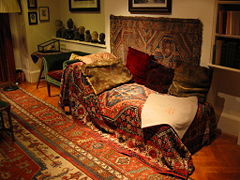Sigmund Freud
2008/9 Schools Wikipedia Selection. Related subjects: Human Scientists
| Sigmund Freud | |
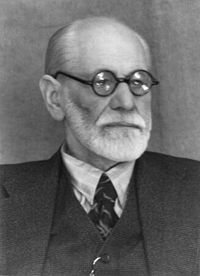 Photo of Sigmund Freud, 1938
|
|
| Born | May 6, 1856 Freiberg, Moravia, now the Czech Republic |
|---|---|
| Died | September 23, 1939 (aged 83) London |
| Residence | Austria, (later) England |
| Nationality | Austrian |
| Ethnicity | Jewish |
| Fields | Neurology, Philosophy, Psychiatry, Psychology, Psychotherapy, Psychoanalysis |
| Institutions | University of Vienna |
| Alma mater | University of Vienna |
| Doctoral advisor | Jean-Martin Charcot, (later) Josef Breuer |
| Doctoral students | Alfred Adler, John Bowlby, Viktor Frankl, Anna Freud, Ernest Jones, Carl Jung, Melanie Klein, Jacques Lacan, Fritz Perls, Otto Rank, Wilhelm Reich, Donald Winnicott |
| Known for | Psychoanalysis |
| Notable awards | Goethe Prize |
Sigmund Freud (IPA: [ˈziːkmʊnt ˈfʁɔʏt]), born Shlomo Sigismund Freud ( May 6, 1856 – September 23, 1939), was an Austrian physician who founded the psychoanalytic school of psychology. Freud is best known for his theories of the unconscious mind and the defense mechanism of repression and for creating the clinical practice of psychoanalysis for curing psychopathology through dialogue between a patient and a psychoanalyst. Freud is also renowned for his redefinition of sexual desire as the primary motivational energy of human life, as well as his therapeutic techniques, including the use of free association, his theory of transference in the therapeutic relationship, and the interpretation of dreams as sources of insight into unconscious desires.
Biography
Early life
Sigmund Freud was born on 6 May 1856 to Galician Jewish parents in Příbor (German: Freiberg in Mähren), Moravia, Austrian Empire, now Czech Republic. His father Jakob was 41, a wool merchant, and had two children by a previous marriage. His mother Amalié (née Nathansohn), the second wife of Jakob, was 21. He was the first of their eight children and owing to his precocious intellect, his parents favoured him over his siblings from the early stages of his childhood; and despite their poverty, they sacrificed everything to give him a proper education. Due to the economic crisis of 1857, father Freud lost his business, and the family moved first to Leipzig before settling in Vienna. In 1865, Sigmund entered the Leopoldstädter Kommunal-Realgymnasium, a prominent high school. Freud was an outstanding pupil and graduated the Matura in 1873 with honours.
After planning to study law, Freud joined the medical faculty at University of Vienna to study under Darwinist Prof. Karl Claus. At that time, eel life history was still unknown, and due to their mysterious origins and migrations, a racist association was often made between eels and Jews and Gypsies. In search for their male sex organs, Freud spent four weeks at the Austrian zoological research station in Trieste, dissecting hundreds of eels without finding more than his predecessors such as Simon von Syrski. In 1876, he published his first paper about "the testicles of eels" in the "Mitteilungen der österreichischen Akademie der Wissenschaften", conceding that he could not solve the matter either. Frustrated by the lack of success that would have gained him fame, Freud chose to change his course of study. Biographers like Siegfried Bernfeld wonder if and how this early episode was significant for his later work regarding hidden sexuality and frustrations.
Medical school
In 1874, the concept of " psychodynamics" was proposed with the publication of Lectures on Physiology by German physiologist Ernst Wilhelm von Brücke who, in coordination with physicist Hermann von Helmholtz, one of the formulators of the first law of thermodynamics ( conservation of energy), supposed that all living organisms are energy-systems also governed by this principle. During this year, at the University of Vienna, Brücke served as supervisor for first-year medical student Sigmund Freud who adopted this new "dynamic" physiology. In his Lectures on Physiology, Brücke set forth the radical view that the living organism is a dynamic system to which the laws of chemistry and physics apply. This was the starting point for Freud's dynamic psychology of the mind and its relation to the unconscious. The origins of Freud’s basic model, based on the fundamentals of chemistry and physics, according to John Bowlby, stems from Brücke, Meynert, Breuer, Helmholtz, and Herbart. In 1879, Freud interrupted his studies to complete his one year of obligatory military service, and in 1881 he received his Dr. med. (M.D.) with the thesis Über das Rückenmark niederer Fischarten ("on the spinal cord of lower fish species").
Freud and psychoanalysis
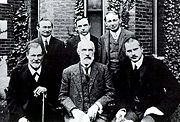
In October 1885 Freud went to Paris on a travelling fellowship to study with Europe's most renowned neurologist, Jean Martin Charcot. He was later to remember the experience of this stay as catalytic in turning him toward the practice of medical psychopathology and away from a less financially promising career in research neurology. Charcot specialised in the study of hysteria and its susceptibility to hypnosis which he frequently demonstrated with patients on stage in front of an audience. Freud later turned away from hypnosis as a potential cure, favouring free association and dream analysis. Charcot himself questioned his own work on hysteria towards the end of his life.
After opening his own medical practice, specializing in neurology, Freud married Martha Bernays in 1886. Her father Berman was the son of Isaac Bernays chief rabbi in Hamburg. After experimenting with hypnosis on his neurotic patients, Freud abandoned this form of treatment as it proved ineffective for many, in favour of a treatment where the patient talked through his or her problems. This came to be known as the "talking cure", as the ultimate goal of this talking was to locate and release powerful emotional energy that had initially been rejected, and imprisoned in the unconscious mind. Freud called this denial of emotions " repression", and he believed that it was often damaging to the normal functioning of the psyche, and could also retard physical functioning as well, which he described as " psychosomatic" symptoms. (The term "talking cure" was initially coined by the patient Anna O. who was treated by Freud's colleague Josef Breuer.) The "talking cure" is widely seen as the basis of psychoanalysis.
There has long been dispute about the possibility that a romantic liaison blossomed between Freud and his sister-in-law, Minna Bernays, who had moved into Freud's apartment at 19 Berggasse in 1896. It has been suggested that the affair resulted in a pregnancy and subsequently an abortion for Miss Bernays. A hotel log dated August 13, 1898 has been suggested to support the allegation of an affair.
In his 40s, Freud "had numerous psychosomatic disorders as well as exaggerated fears of dying and other phobias" (Corey 2001, p. 67). During this time Freud was involved in the task of exploring his own dreams, memories, and the dynamics of his personality development. During this self-analysis, he came to realize the hostility he felt towards his father (Jacob Freud), who had died in 1896, and "he also recalled his childhood sexual feelings for his mother (Amalia Freud), who was attractive, warm, and protective" (Corey 2001, p. 67). Corey (2001) considers this time of emotional difficulty to be the most creative time in Freud's life.
After the publication of Freud's books in 1900 and 1902, interest in his theories began to grow, and a circle of supporters developed in the following period. Freud often chose to disregard the criticisms of those who were skeptical of his theories, however, which earned him the animosity of a number of individuals, the most famous being Carl Jung, who originally supported Freud's ideas. Part of the reason for their fallout was due to Jung's growing commitment to religion and mysticism, which conflicted with Freud's atheism.
Last years
In 1930, Freud received the Goethe Prize in appreciation of his contribution to psychology and to German literary culture. Three years later the Nazis took control of Germany and Freud's books featured prominently among those burned and destroyed by the Nazis. In March 1938, Nazi Germany annexed Austria in the Anschluss. This led to violent outbursts of anti-Semitism in Vienna, and Freud and his family received visits from the Gestapo. Freud decided to go into exile "to die in freedom". He and his family left Vienna in June 1938 and moved to Hampstead, London.
A heavy cigar smoker, Freud endured more than 30 operations during his life due to oral cancer. In September 1939 he prevailed on his doctor and friend Max Schur to assist him in suicide. After reading Balzac's La Peau de chagrin in a single sitting he said, "My dear Schur, you certainly remember our first talk. You promised me then not to forsake me when my time comes. Now it is nothing but torture and makes no sense any more." Schur administered three doses of morphine over many hours that resulted in Freud's death on September 23, 1939. Three days after his death, Freud's body was cremated at Golders Green Crematorium in England during a service attended by Austrian refugees, including the author Stefan Zweig. His ashes were later placed in the crematorium's columbarium. They rest in an ancient Greek urn which Freud had received as a present from Marie Bonaparte and which he had kept in his study in Vienna for many years. After Martha Freud's death in 1951, her ashes were also placed in that urn. Golders Green Crematorium has since also become the final resting place for Anna Freud and her lifelong friend Dorothy Burlingham, as well as for several other members of the Freud family.
Freud's ideas
Freud has been influential in two related but distinct ways. He simultaneously developed a theory of how the human mind is organized and operates internally, and a theory of how human behaviour both conditions and results from this particular theoretical understanding. This led him to favour certain clinical techniques for attempting to help cure psychopathology. He theorized that personality is developed by the person's childhood experiences.
Early work
Since neurology and psychiatry were not recognized as distinct medical fields at the time of Freud's training, the medical degree he obtained after studying for six years at the University of Vienna board certified him in both fields, although he is far more well-known for his work in the latter. As far as neurology went, Freud was an early researcher on the topic of neurophysiology, specifically cerebral palsy, which was then known as "cerebral paralysis." He published several medical papers on the topic, and showed that the disease existed far before other researchers in his day began to notice and study it. He also suggested that William Little, the man who first identified cerebral palsy, was wrong about lack of oxygen during the birth process being a cause. Instead, he suggested that complications in birth were only a symptom of the problem. It was not until the 1980s that Freud's speculations were confirmed by more modern research.
Freud hoped that his research would provide a solid scientific basis for his therapeutic technique. The goal of Freudian therapy, or psychoanalysis, was to bring to consciousness repressed thoughts and feelings in order to free the patient from the suffering caused by the repetitive return of distorted forms of these thoughts and feelings. According to some of his successors, including his daughter Anna Freud, the goal of therapy is to allow the patient to develop a stronger ego.
Classically, the bringing of unconscious thoughts and feelings to consciousness is brought about by encouraging the patient to talk in free association and to talk about dreams. Another important element of psychoanalysis is a relative lack of direct involvement on the part of the analyst, which is meant to encourage the patient to project thoughts and feelings onto the analyst. Through this process, transference, the patient can reenact and resolve repressed conflicts, especially childhood conflicts with (or about) parents.
The origin of Freud's early work with psychoanalysis can be linked to Joseph Breuer. Freud actually credits Breuer with the discovery of the psychoanalytical method. One case started this phenomenon that would shape the field of psychology for decades to come, the case of Anna O. In 1880 a young girl came to Breuer with symptoms of what was then called female hysteria. Anna O. was a highly intelligent 21-year-old woman. She presented with symptoms such as paralysis of the limbs, dissociation, and amnesia; today this set of symptoms are known as conversion disorder. After many doctors had given up and accused Anna O. of faking her symptoms, Breuer decided to treat her sympathetically, which he did with all of his patients. He started to hear her mumble words during what he called states of absence. Eventually Breuer started to recognize some of the words and wrote them down. He then hypnotized her and repeated the words to her; Breuer found out that the words were associated with her father's illness and death.
In the early 1890s Freud used a form of treatment based on the one that Breuer had described to him, modified by what he called his "pressure technique". The traditional story, based on Freud's later accounts of this period, is that as a result of his use of this procedure most of his patients in the mid-1890s reported early childhood sexual abuse. He believed these stories, but after being heavily criticized for this belief and hearing a patient tell the story about Freud's personal friend being a victimizer, Freud concluded that his patients were fantasizing the abuse scenes.
In 1896 Freud posited that the symptoms of 'hysteria' and obsessional neurosis derived from unconscious memories of sexual abuse in infancy, and claimed that he had uncovered such incidents for every single one of his current patients (one third of whom were men). However a close reading of his papers and letters from this period indicates that these patients did not report early childhood sexual abuse as he later claimed: rather, he based his claims on analytically inferring the supposed incidents, using a procedure that was heavily dependent on the symbolic interpretation of somatic symptoms.
Freud and cocaine
Freud was an early user and proponent of cocaine as a stimulant as well as analgesic. He wrote several articles on the antidepressant qualities of the drug and he was influenced by his friend and confidant Wilhelm Fliess, who recommended cocaine for the treatment of the "nasal reflex neurosis." Fliess operated on Freud and a number of Freud's patients whom he believed to be suffering from the disorder, including Emma Eckstein, whose surgery proved disastrous..
Freud felt that cocaine would work as a panacea for many disorders and wrote a well-received paper, "On Coca," explaining its virtues. He prescribed it to his friend Ernst von Fleischl-Marxow to help him overcome a morphine addiction he had acquired while treating a disease of the nervous system. Freud also recommended it to many of his close family and friends. He narrowly missed out on obtaining scientific priority for discovering cocaine's anesthetic properties (of which Freud was aware but on which he had not written extensively), after Karl Koller, a colleague of Freud's in Vienna, presented a report to a medical society in 1884 outlining the ways in which cocaine could be used for delicate eye surgery. Freud was bruised by this, especially because this would turn out to be one of the few safe uses of cocaine, as reports of addiction and overdose began to filter in from many places in the world. Freud's medical reputation became somewhat tarnished because of this early ambition. Furthermore, Freud's friend Fleischl-Marxow developed an acute case of "cocaine psychosis" as a result of Freud's prescriptions and died a few years later. Freud felt great regret over these events, which later biographers have dubbed "The Cocaine Incident." However, he managed to move on, and even continued to use cocaine.
Dr. Jurgen von Scheidt speculated that most of Freud's psychoanalytical theory was a byproduct of his cocaine use.
The Unconscious
Perhaps the most significant contribution Freud made to Western thought were his arguments concerning the importance of the unconscious mind in understanding conscious thought and behaviour. However, as psychologist Jacques Van Rillaer pointed out, "contrary to what most people believe, the unconscious was not discovered by Freud. In 1890, when psychoanalysis was still unheard of, William James, in his monumental treatise on psychology, examined the way Schopenhauer, von Hartmann, Janet, Binet and others had used the term 'unconscious' and 'subconscious'". Boris Sidis, a Russian Jew who emigrated to the United States of America in 1887, and studied under William James, wrote The Psychology of Suggestion: A Research into the Subconscious Nature of Man and Society in 1898, followed by ten or more works over the next twenty five years on similar topics to the works of Freud. Historian of psychology Mark Altschule concluded, "It is difficult - or perhaps impossible - to find a nineteenth-century psychologist or psychiatrist who did not recognize unconscious cerebration as not only real but of the highest importance." Freud's advance was not to uncover the unconscious but to devise a method for systematically studying it.
Freud called dreams the "royal road to the unconscious". This meant that dreams illustrate the "logic" of the unconscious mind. Freud developed his first topology of the psyche in The Interpretation of Dreams (1899) in which he proposed that the unconscious exists and described a method for gaining access to it. The preconscious was described as a layer between conscious and unconscious thought; its contents could be accessed with a little effort.
One key factor in the operation of the unconscious is " repression." Freud believed that many people "repress" painful memories deep into their unconscious mind. Although Freud later attempted to find patterns of repression among his patients in order to derive a general model of the mind, he also observed that repression varies among individual patients. Freud also argued that the act of repression did not take place within a person's consciousness. Thus, people are unaware of the fact that they have buried memories or traumatic experiences.
Later, Freud distinguished between three concepts of the unconscious: the descriptive unconscious, the dynamic unconscious, and the system unconscious. The descriptive unconscious referred to all those features of mental life of which people are not subjectively aware. The dynamic unconscious, a more specific construct, referred to mental processes and contents which are defensively removed from consciousness as a result of conflicting attitudes. The system unconscious denoted the idea that when mental processes are repressed, they become organized by principles different from those of the conscious mind, such as condensation and displacement.
Eventually, Freud abandoned the idea of the system unconscious, replacing it with the concept of the Ego, super-ego, and id (discussed below). Throughout his career, however, he retained the descriptive and dynamic conceptions of the unconscious.
Ego, super-ego, and id
In his later work, Freud proposed that the psyche could be divided into three parts: ego, super-ego, and id. The id is the impulsive, child-like portion of the psyche that operates on the "pleasure principle" and only takes into account what it wants and disregards all consequences. The super-ego is the moral component of the psyche, which takes into account no special circumstances in which the morally right thing may not be right for a given situation. The rational ego attempts to exact a balance between the impractical hedonism of the id and the equally impractical moralism of the super-ego. When overburdened or threatened by this task, it may employ defense mechanisms including denial, repression, and displacement. The ego is the part of the psyche that is, usually, reflected most directly in a person's actions.
Attention to elements of this mental model spans the decades both before and after Freud published his seminal material about the model. Freud discussed this structural model in the 1920 essay Beyond the Pleasure Principle, and fully elaborated it in The Ego and the Id (1923), where he developed it as an alternative to his previous topographic schema (conscious, unconscious, preconscious). Freud acknowledged that his use of the term Id (das Es, "the It") derives from the writings of Georg Grodeck. The term Id appears in the earliest writing of Boris Sidis, attributed to William James, as early as 1898. The theory of ego defense mechanisms has received empirical validation, and the nature of repression, in particular, became one of the more fiercely debated areas of psychology in the 1990s.
The life and death drives
Freud believed that humans were driven by two conflicting central desires: the life drive ( libido) (survival, propagation, hunger, thirst, and sex) and the death drive ( Thanatos). Freud's description of Cathexis, whose energy is known as libido, included all creative, life-producing drives. The death drive (or death instinct), whose energy is known as anticathexis, represented an urge inherent in all living things to return to a state of calm: in other words, an inorganic or dead state. Freud recognized Thanatos only in his later years and developed his theory on the death drive in Beyond the Pleasure Principle. Freud approached the paradox between the life drives and the death drives by defining pleasure and unpleasure. According to Freud, unpleasure refers to stimulus that the body receives. (For example, excessive friction on the skin's surface produces a burning sensation; or, the bombardment of visual stimuli amidst rush hour traffic produces anxiety.) Conversely, pleasure is a result of a decrease in stimuli (for example, a calm environment the body enters after having been subjected to a hectic environment). If pleasure increases as stimuli decreases, then the ultimate experience of pleasure for Freud would be zero stimulus, or death.
Given this proposition, Freud acknowledged the tendency for the unconscious to repeat unpleasurable experiences in order to desensitize, or deaden, the body. This compulsion to repeat unpleasurable experiences explains why traumatic nightmares occur in dreams, as nightmares seem to contradict Freud's earlier conception of dreams purely as a site of pleasure, fantasy, and desire. On the one hand, the life drives promote survival by avoiding extreme unpleasure and any threat to life. On the other hand, the death drive functions simultaneously toward extreme pleasure, which leads to death. Freud addressed the conceptual dualities of pleasure and unpleasure, as well as sex/life and death, in his discussions on masochism and sadomasochism. The tension between Eros and Thanatos represented a revolution in his manner of thinking.
These ideas resemble aspects of the philosophies of Arthur Schopenhauer and Friedrich Nietzsche. Schopenhauer's pessimistic philosophy, expounded in The World as Will and Representation, describes a renunciation of the will to live that corresponds on many levels with Freud's Death Drive. Similarly, the life drive clearly parallels much of Nietzsche's concept of the Dionysian in The Birth of Tragedy. However, Freud denied having been acquainted with their writings before he formulated the groundwork of his own ideas.
Freud's legacy
Psychotherapy
Freud's theories and research methods have always been controversial. However, Freud has had a tremendous impact on psychotherapy. Many psychotherapists follow Freud's approach to a greater or lesser extent, even if they reject Freud's theories. One influential post-Freudian psychotherapy has been the primal therapy of the American psychologist Arthur Janov.
Freud's contributions to psychotherapy have been extensively criticised by scholars and historians.
H. J. Eysenck wrote that Freud 'set psychiatry back one hundred years', consistently mis-diagnosed his patients, fraudulently misrepresented case histories and that "what is true in Freud is not new and what is new in Freud is not true".
Mikkel Borch-Jacobsen wrote in a review of Han Israëls's book Der Fall Freud published in The London Review of Books that, "The truth is that Freud knew from the very start that Fleischl, Anna O. and his 18 patients were not cured, and yet he did not hesitate to build grand theories on these non-existent foundations...he disguised fragments of his self-analysis as ‘objective’ cases, that he concealed his sources, that he conveniently antedated some of his analyses, that he sometimes attributed to his patients ‘free associations’ that he himself made up, that he inflated his therapeutic successes, that he slandered his opponents."
Philosophy
Freud did not consider himself a philosopher, although he greatly admired Franz Brentano, known for his theory of perception, as well as Theodor Lipps, who was one of the main supporters of the ideas of the subconscious and empathy. In his 1932 lecture on psychoanalysis as "a philosophy of life" Freud commented on the distinction between science and philosophy:
- Philosophy is not opposed to science, it behaves itself as if it were a science, and to a certain extent it makes use of the same methods; but it parts company with science, in that it clings to the illusion that it can produce a complete and coherent picture of the universe, though in fact that picture must needs fall to pieces with every new advance in our knowledge. Its methodological error lies in the fact that it over-estimates the epistemological value of our logical operations, and to a certain extent admits the validity of other sources of knowledge, such as intuition.
Freud's model of the mind is often considered a challenge to the enlightenment model of rational agency, which was a key element of much modern philosophy. Freud's theories have had a tremendous effect on the Frankfurt school and critical theory. Freud had an incisive influence on some French philosophers following the "return to Freud" of the French psychoanalyst Jacques Lacan.
Patients
Freud used pseudonyms in his case histories. Many of the people identified only by pseudonyms were traced to their true identities by Peter Swales. This is a partial list of patients whose case studies were published by Freud:
- Anna O. = Bertha Pappenheim (1859–1936)
- Cäcilie M. = Anna von Lieben
- Dora = Ida Bauer (1882–1945)
- Frau Emmy von N. = Fanny Moser
- Fräulein Elisabeth von R. = Ilona Weiss
- Fräulein Katharina = Aurelia Kronich
- Fräulein Lucy R.
- Little Hans = Herbert Graf (1903–1973)
- Rat Man = Ernst Lanzer (1878–1914)
- Wolf Man = Sergei Pankejeff (1887–1979)
Other patients:
- H.D. (1886–1961)
- Emma Eckstein (1865–1924)
- Gustav Mahler (1860–1911) (single consultation only)
- Princess Marie Bonaparte
People on whom psychoanalytic observations were published but who were not patients:
- Daniel Paul Schreber (1842–1911)
- Woodrow Wilson (1856–1924) (co-authored with and primarily written by William Bullitt)
- Michelangelo, in Freud's essay The Moses of Michelangelo
- Leonardo da Vinci, in Freud's book Leonardo da Vinci and a Memory of His Childhood
- Moses, in Freud's book Moses and Monotheism
- Josef Popper-Lynkeus, in Freud's paper Josef Popper-Lynkeus and the Theory of Dreams
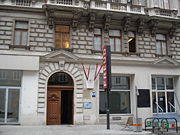
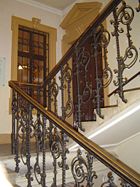
![Sigmund Freud memorial in Hampstead, North London. Sigmund and Anna Freud lived at 20 Maresfield Gardens, near to this statue. Their house is now a museum dedicated to Freud's life and work. [1] The building behind the statue is the Tavistock Clinic, a major psychiatric institution.](../../images/819/81926.jpg)
